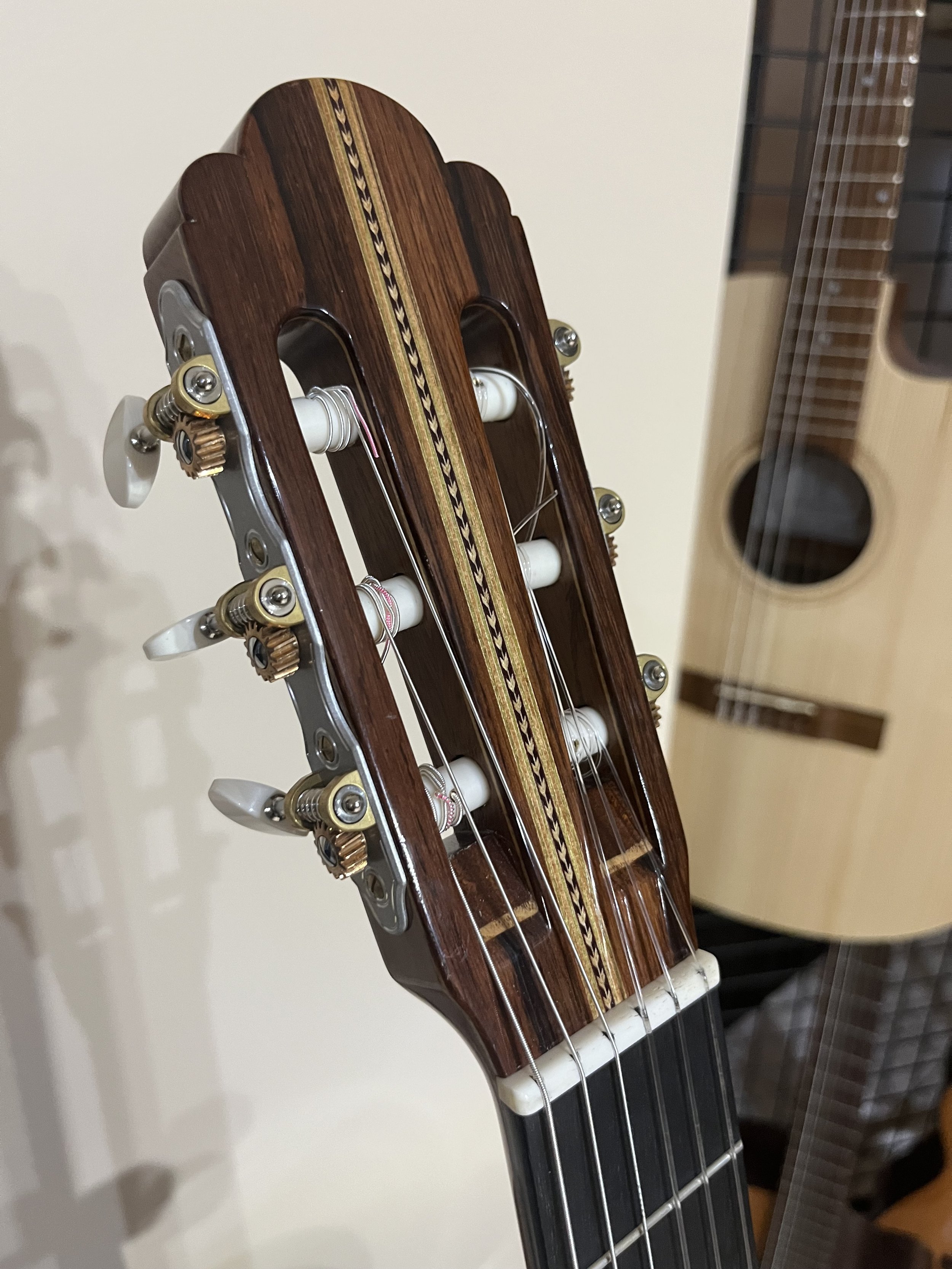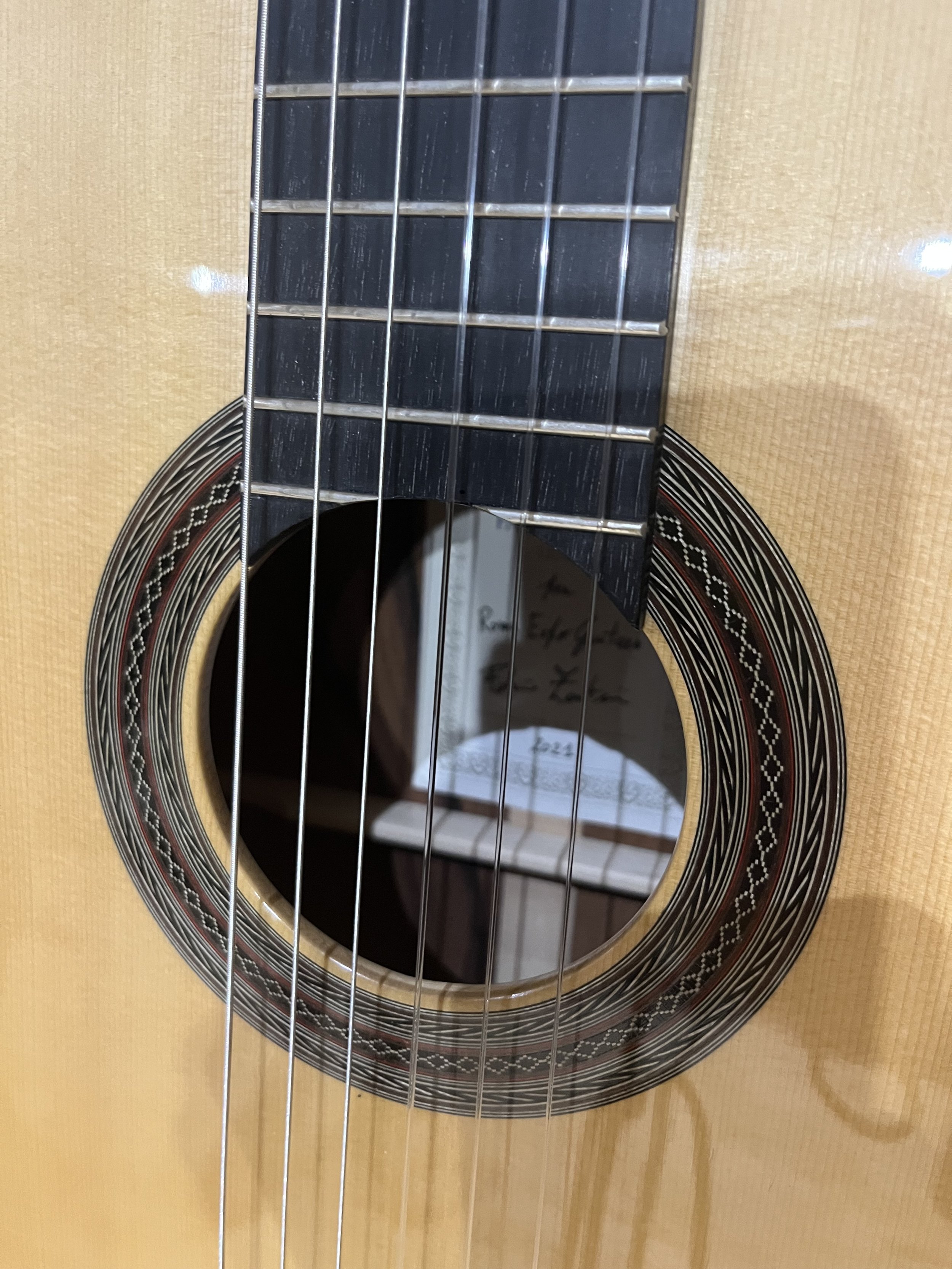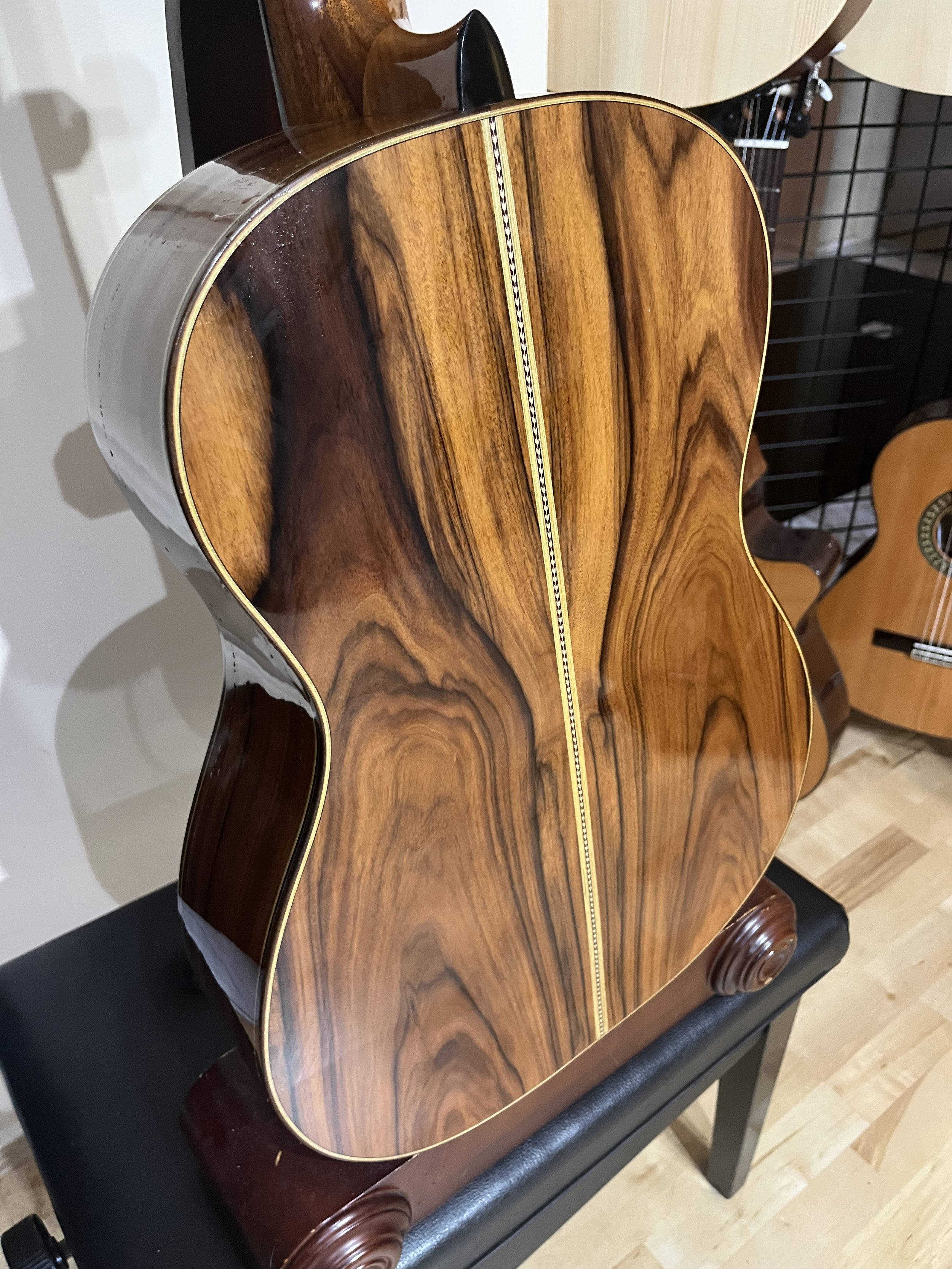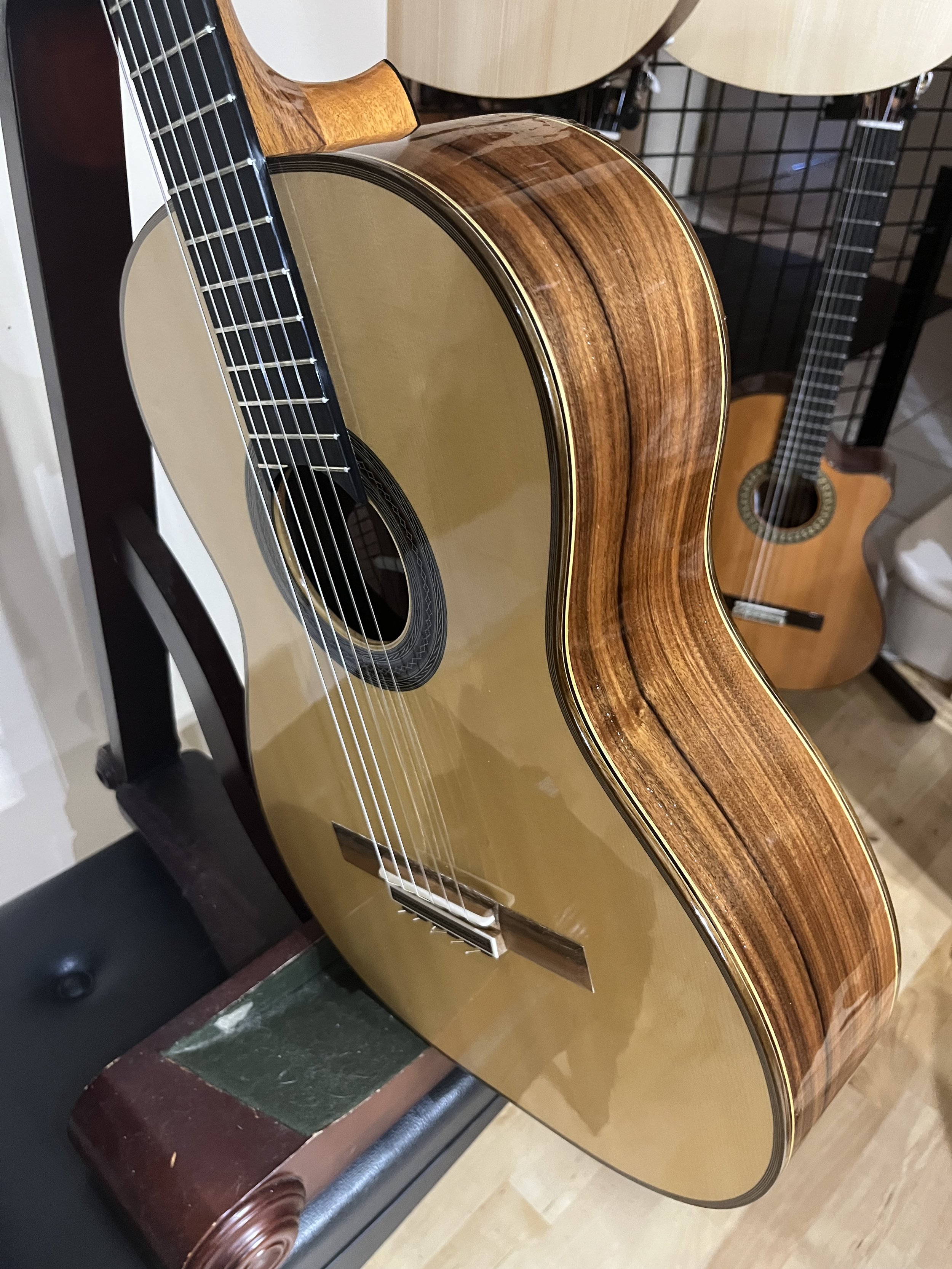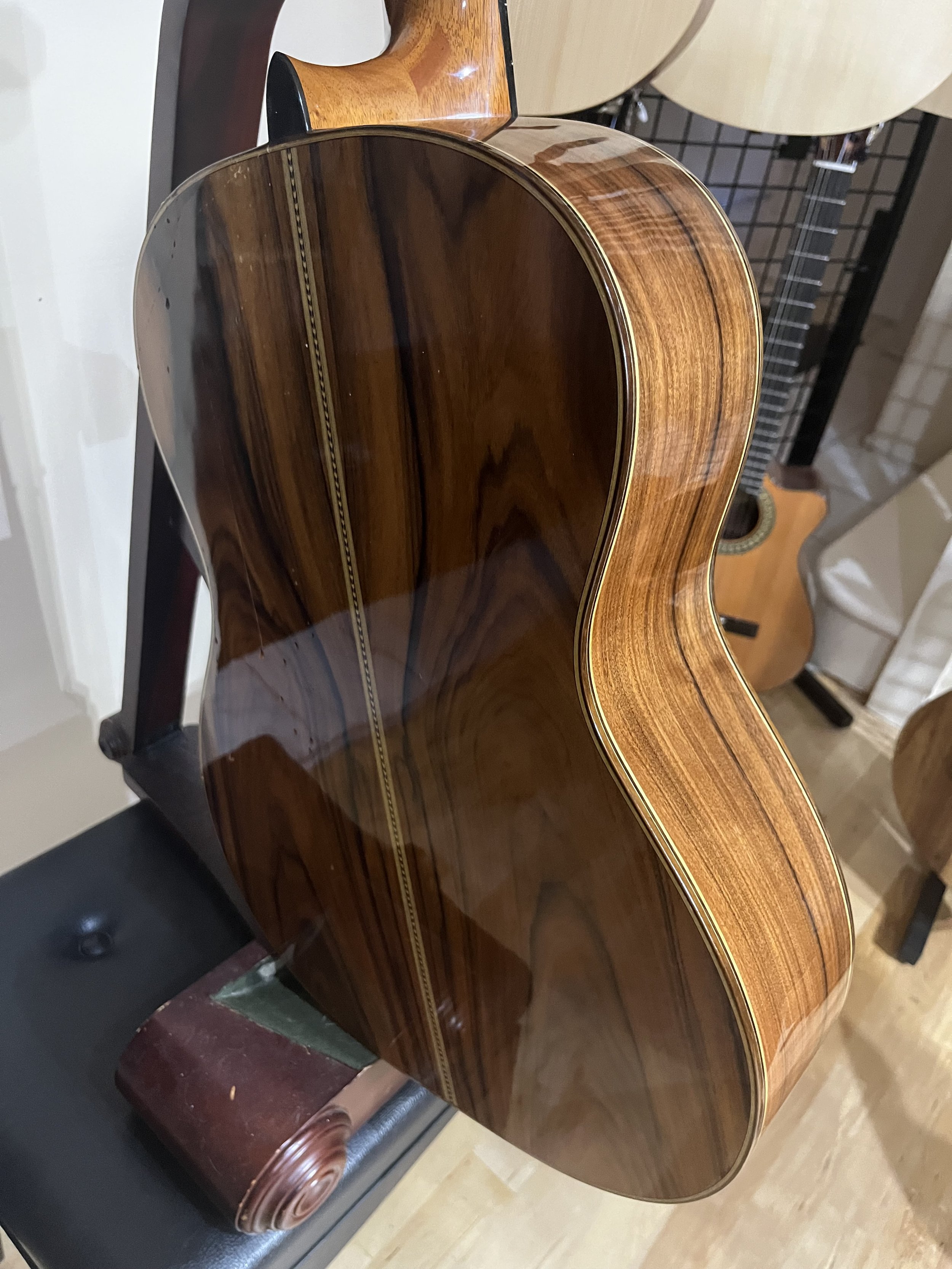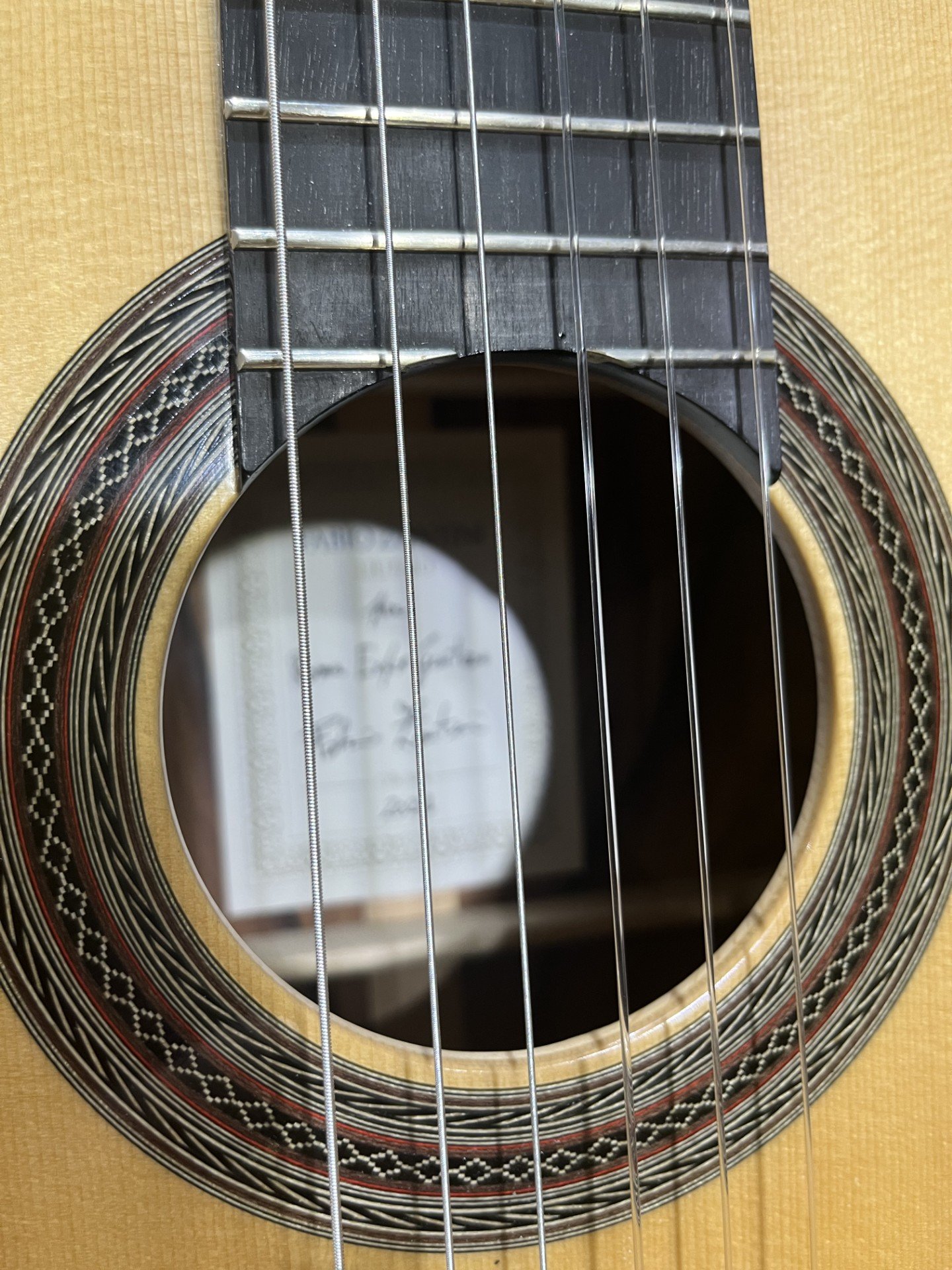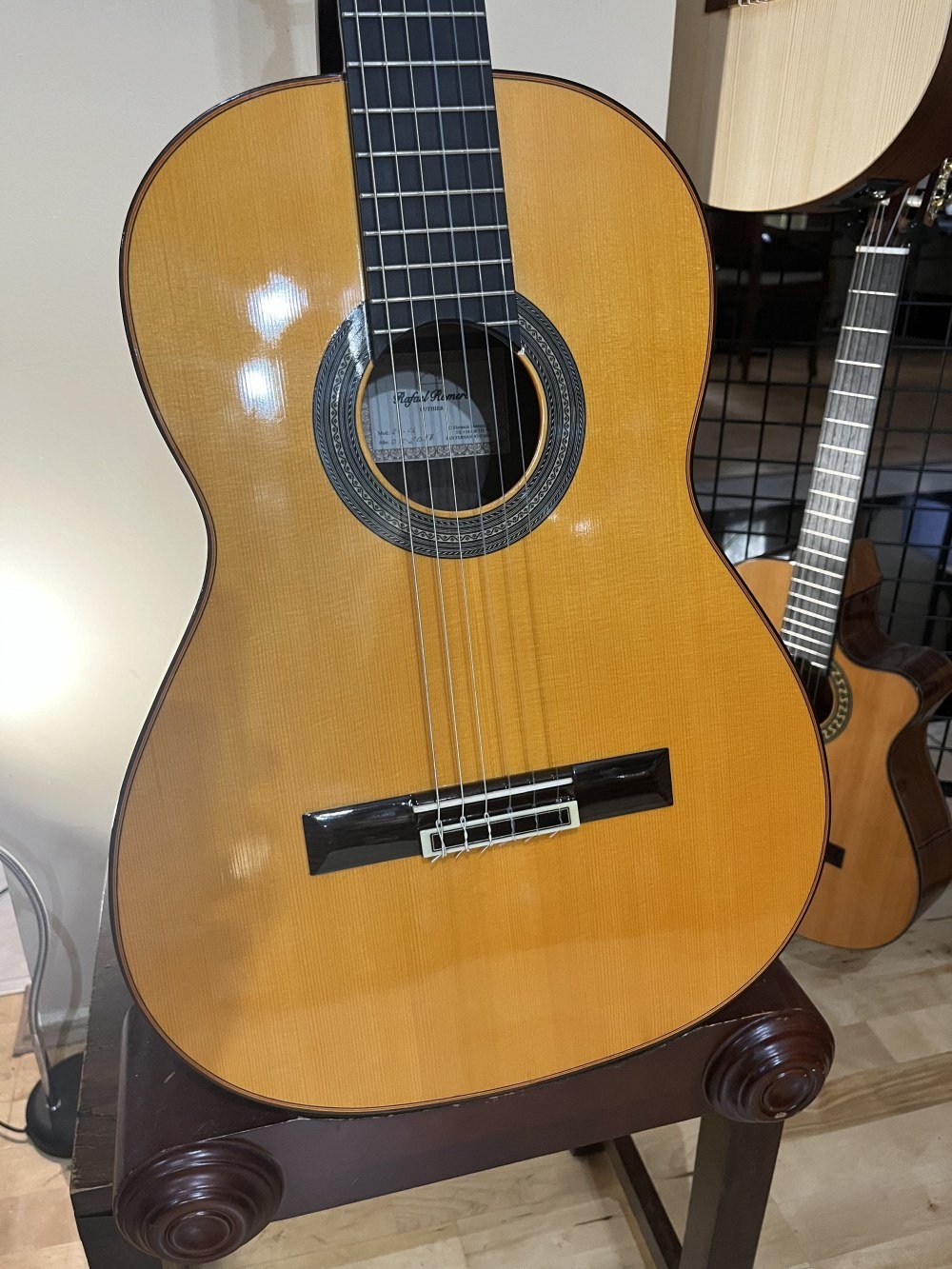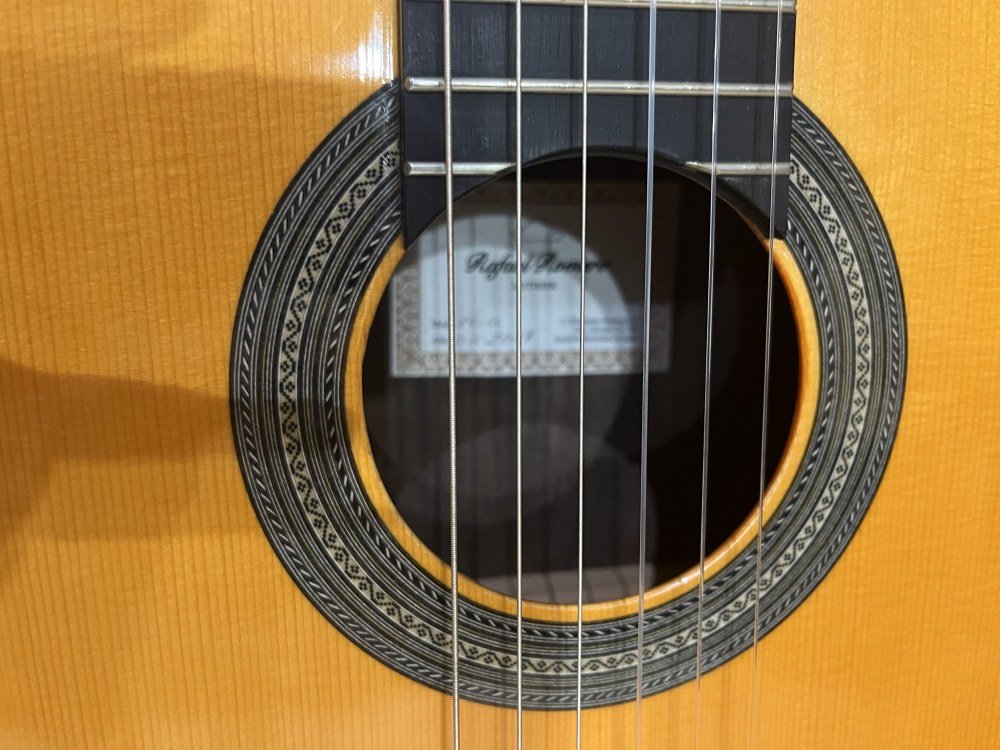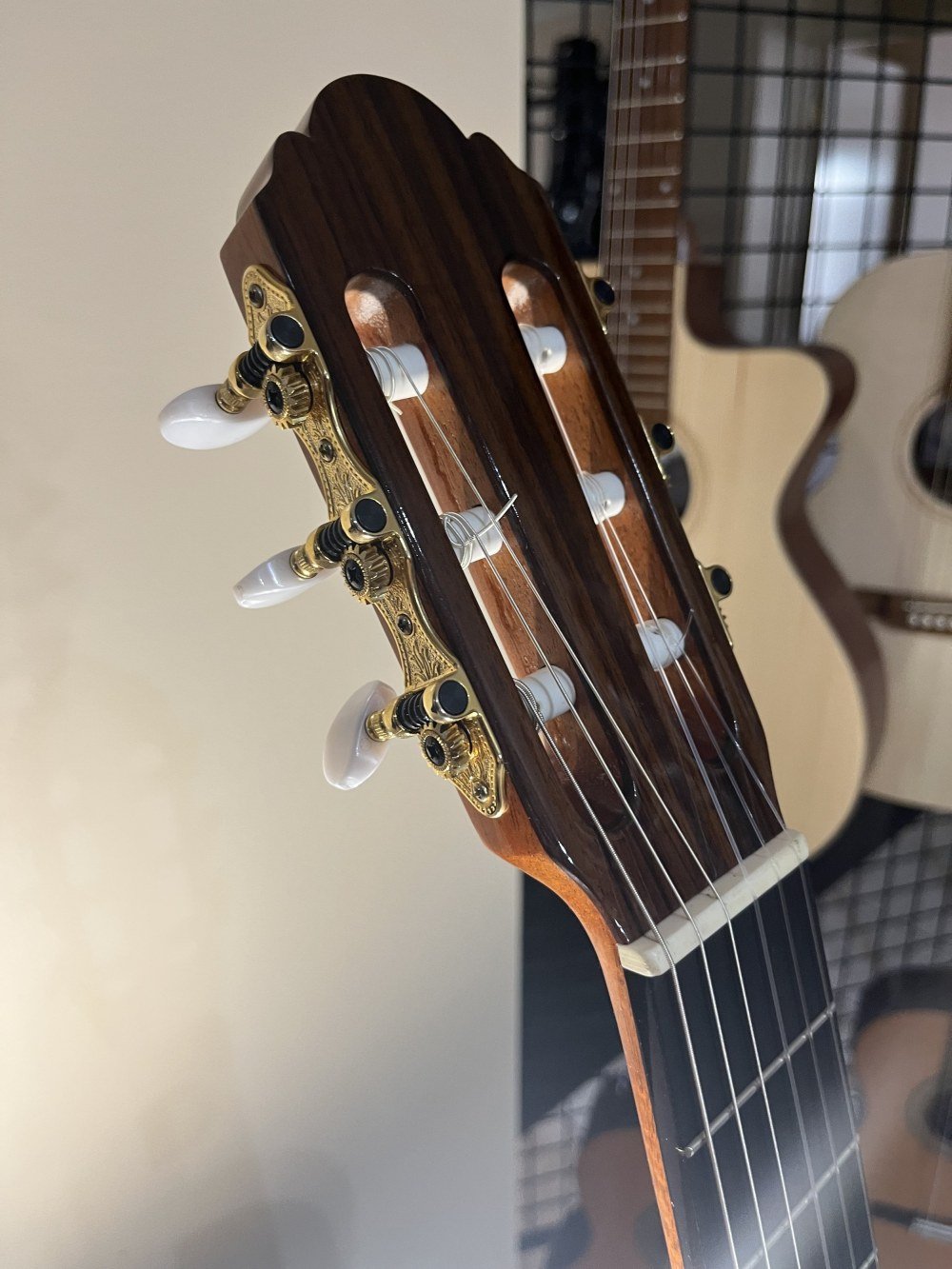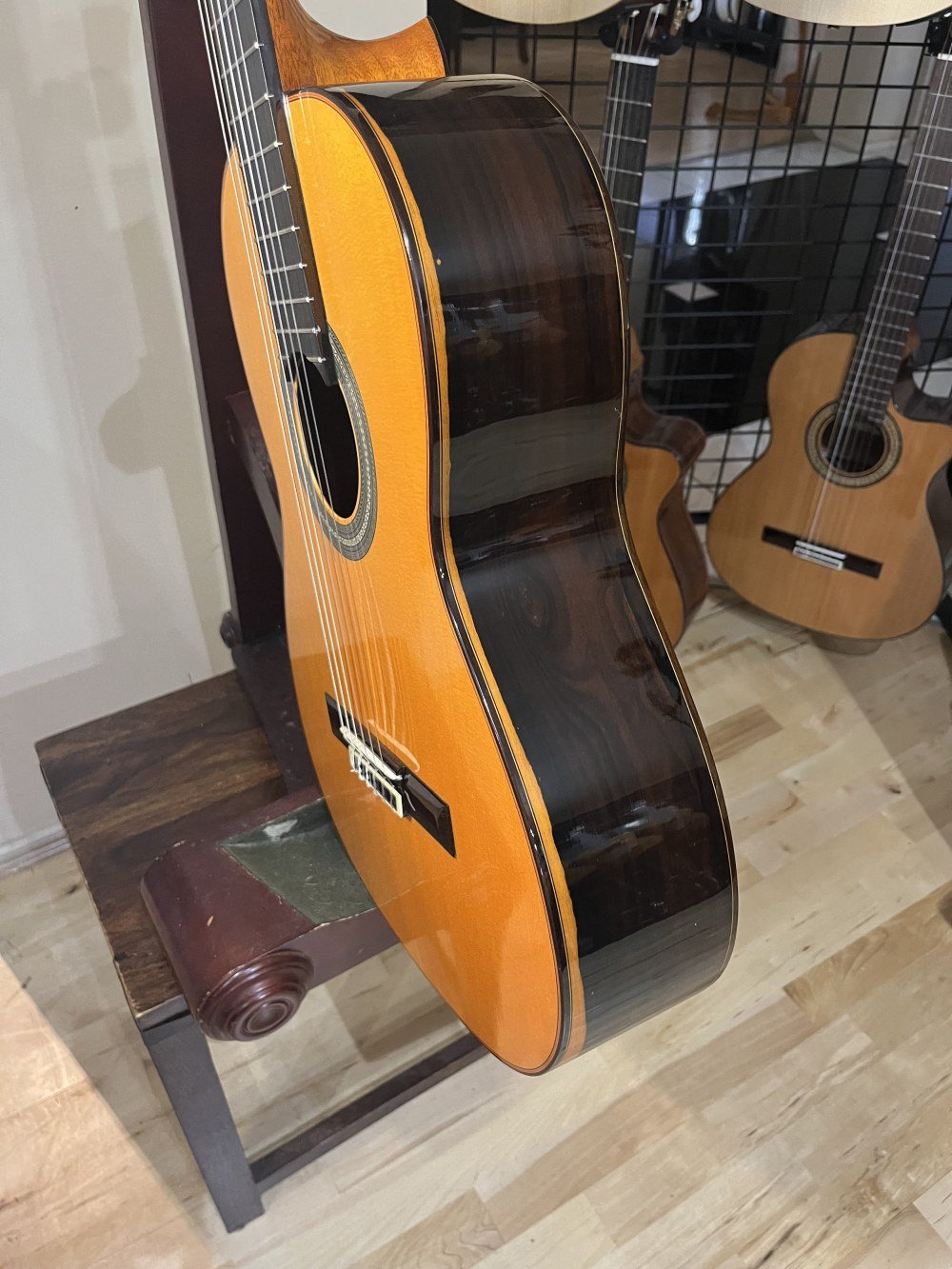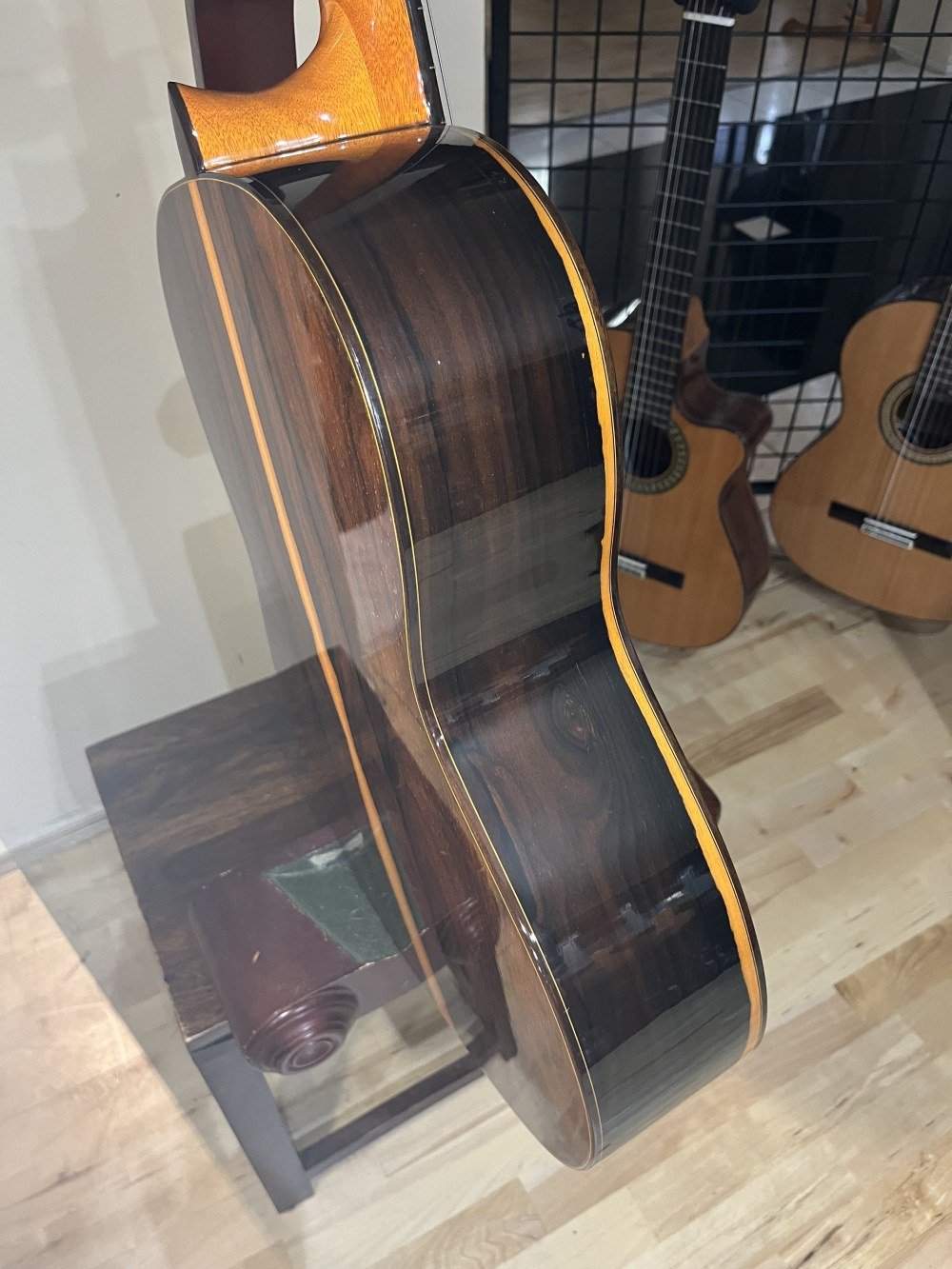2021 Fabio Zontini Herman Hauser 1937 (Ex Segovia) special edition instrument, presented at Roma Expo Guitars
=> please CLICK HERE to see this guitar in action:
Details:
Model: Herman Hauser 1937 (Ex Segovia)
Top: Val di Fiemme Spruce
Back & Sides: Pao Ferro (Bolivian Rosewood)
Neck: Mahogany
Fingerboard: Ebony
Tuners: Pagos Guitar Tuners
Scale Length: 650mm
Finish: Shellac
Condition: Excellent
Case: Leona Carbon case
Strings: Christal 540 Strings that best suit the guitar Fabio Zontini suggests Nylon mid tension
The maker
I was born in Milan in 1971. I obtained the diploma of Master Luthier Restorer at the Civica Scuola di Liuteria in Milan in 1996.
In my professional activity I have created more than 250 instruments drawing inspiration from the Masters of historical lutherie.
Of fundamental importance was the possibility of viewing and measuring works by authors such as Antonio De Torres, Hermann Hauser I, Pietro Gallinotti, Francisco Simplicio, Louis Panormo, just to name a few, who have contributed enormously to developing my way of conceiving sound and aesthetics.
In 2007, at the Barcelona Music Museum, I conducted an in-depth study on the 1859 guitar that belonged to Miguel Llobet, which inspired Hauser I to make his Spanish-style instruments, and the famous “ Papier Machè ” (a guitar with cardboard sides and back from 1862), both made by Antonio De Torres and of which I have produced several copies over the years.
zontiniguitars.com
The Guitar
This guitar was featured in the REG Guitar Test 2021, played by Maestro Andrea De Vitis. You can see the video here:
Demo:
Roma Expo Guitars – Andrea De Vitis Guitar Test
Description 2021 Fabio Zontini Herman Hauser 1937 (Ex Segovia) presented at the Rome Guitar Expo
The Guitar and his building process in the makers Own Words
The 2021 is a guitar inspired by a historical instrument the 1937 Hauser that belonged to Andreas Segovia an instrument he used until 1962. The original is kept at the Metropolitan Museum in New York to make 2021 Hausser I used measurements made by the American luthier Richard Brunet like the original, my guitar has a spruce soundboard back and sides are made of Brazilian rosewood and has a 650mm scale length. Segovia's guitar is an instrument that is central in my opinion in the history of the evolution of the classical guitar. In a 1954 magazine called Guitar Review he called it "the greatest guitar of our time". I believe it is fundamental, not just this single instrument but all the work done by Hauser from the moment he devoted himself to building in the Spanish style he made this guitar using Llobet's famous Torres guitar as a model the FE09 of 1859 which, among other things, I too have had the opportunity to analyse and measure about a dozen years ago at the Music Museum of Barcelona... where it is kept. That Torres guitar was a source of inspiration we can also deduce from the fact that for example the rosette design was taken up by Hauser for many of his guitars. But Hauser didn't just copy, he reinvented the instrument according to his own taste and what could have been his own idea of sound thus finally creating an instrument that is wrong to define better than Torres' but one that is certainly very versatile and suitable for playing most of the contemporary repertoire from a design point of view, Hauser redesigned the curves of the template and enlarged it by increasing its vibrating surface increased the thickness of the soundboard and also made the choice of adding an under-bridge brace, that is a spruce reinforcement with grain opposite to that of the soundboard precisely glued facing the bridge in which the the central brace fits.
All these elements combined determine the way the instrument works and the acoustic result that results are long-lasting and very balanced sounds for some years now I have also added a personal touch of mine to the historical copies always traditional, therefore without the use of materials such as Nomex or carbon, this is a five-brace guitar project with an under-bridge from which I get a prompt and brilliant instrument which is part of a certain more recent Spanish tradition however, I now also consider the work done over many years on Gallinotti as mine in the sense that I have internalised the three Gallinotti instruments that I have in my repertoire to the point that I can almost define them as my personal project
it is a model from 1965 in spruce and a 1952 model that can be made in both spruce and cedar that from 1952 among other things is the first ever guitar with a cedar soundboard and I believe I was among the first to make copies it is a very interesting project because its timbre is very original retaining some of the typical characteristics of spruce instruments but with a very different sound color a particular mix that can satisfy both spruce and cedar lovers
Q. will there be any news in your production in the future, in the medium or long term?
A. I intend to continue on the path I have taken over the years continuing to work in the field of traditional lutherie which is the one that interests me the most, I would say that it is a vast enough program
Details:
Model: Herman Hauser 1937 (Ex Segovia)
Top: Val di Fiemme Spruce
Back & Sides: Pao Ferro (Bolivian Rosewood)
Neck: Mahogany
Fingerboard: Ebony
Tuners: Pagos Guitar Tuners
Scale Length: 650mm
Finish: Shellac
Condition: Excellent
Case: Leona Carbon case
Strings: Christal 540 Strings that best suit the guitar Fabio Zontini suggests Nylon mid tension
Dan Nistico when playing and reviewing the Fabio Zontini said” We have a very special guitar a Zontini here based on a 1937 Houser played by Segovia. It has a beautiful spruce top and the most beautiful back and sides I have seen. It is a very solid performer in every aspect, clarity, sustain, playability.
Let’s hear some notes around the instrument. Has nice string differentiation, each string is individual has its own colour and differentiation.( Plays a run ) and says Nice!.
This guitar would be nice for the music of Bach or Baroque composers ( plays runs showing clarity). It sounds nice due to the clarity, projection and tone of the Spruce. Plays the Prelude from Suite BWV 1006a” It will bring out a lot of the beautiful characteristic of this guitar”.
=> please CLICK HERE to see this guitar in action:
Details:
Model: Herman Hauser 1937 (Ex Segovia)
Top: Val di Fiemme Spruce
Back & Sides: Pao Ferro (Bolivian Rosewood)
Neck: Mahogany
Fingerboard: Ebony
Tuners: Pagos Guitar Tuners
Scale Length: 650mm
Finish: Shellac
Condition: Excellent
Case: Leona Carbon case
Strings: Christal 540 Strings that best suit the guitar Fabio Zontini suggests Nylon mid tension
The maker
I was born in Milan in 1971. I obtained the diploma of Master Luthier Restorer at the Civica Scuola di Liuteria in Milan in 1996.
In my professional activity I have created more than 250 instruments drawing inspiration from the Masters of historical lutherie.
Of fundamental importance was the possibility of viewing and measuring works by authors such as Antonio De Torres, Hermann Hauser I, Pietro Gallinotti, Francisco Simplicio, Louis Panormo, just to name a few, who have contributed enormously to developing my way of conceiving sound and aesthetics.
In 2007, at the Barcelona Music Museum, I conducted an in-depth study on the 1859 guitar that belonged to Miguel Llobet, which inspired Hauser I to make his Spanish-style instruments, and the famous “ Papier Machè ” (a guitar with cardboard sides and back from 1862), both made by Antonio De Torres and of which I have produced several copies over the years.
zontiniguitars.com
The Guitar
This guitar was featured in the REG Guitar Test 2021, played by Maestro Andrea De Vitis. You can see the video here:
Demo:
Roma Expo Guitars – Andrea De Vitis Guitar Test
Description 2021 Fabio Zontini Herman Hauser 1937 (Ex Segovia) presented at the Rome Guitar Expo
The Guitar and his building process in the makers Own Words
The 2021 is a guitar inspired by a historical instrument the 1937 Hauser that belonged to Andreas Segovia an instrument he used until 1962. The original is kept at the Metropolitan Museum in New York to make 2021 Hausser I used measurements made by the American luthier Richard Brunet like the original, my guitar has a spruce soundboard back and sides are made of Brazilian rosewood and has a 650mm scale length. Segovia's guitar is an instrument that is central in my opinion in the history of the evolution of the classical guitar. In a 1954 magazine called Guitar Review he called it "the greatest guitar of our time". I believe it is fundamental, not just this single instrument but all the work done by Hauser from the moment he devoted himself to building in the Spanish style he made this guitar using Llobet's famous Torres guitar as a model the FE09 of 1859 which, among other things, I too have had the opportunity to analyse and measure about a dozen years ago at the Music Museum of Barcelona... where it is kept. That Torres guitar was a source of inspiration we can also deduce from the fact that for example the rosette design was taken up by Hauser for many of his guitars. But Hauser didn't just copy, he reinvented the instrument according to his own taste and what could have been his own idea of sound thus finally creating an instrument that is wrong to define better than Torres' but one that is certainly very versatile and suitable for playing most of the contemporary repertoire from a design point of view, Hauser redesigned the curves of the template and enlarged it by increasing its vibrating surface increased the thickness of the soundboard and also made the choice of adding an under-bridge brace, that is a spruce reinforcement with grain opposite to that of the soundboard precisely glued facing the bridge in which the the central brace fits.
All these elements combined determine the way the instrument works and the acoustic result that results are long-lasting and very balanced sounds for some years now I have also added a personal touch of mine to the historical copies always traditional, therefore without the use of materials such as Nomex or carbon, this is a five-brace guitar project with an under-bridge from which I get a prompt and brilliant instrument which is part of a certain more recent Spanish tradition however, I now also consider the work done over many years on Gallinotti as mine in the sense that I have internalised the three Gallinotti instruments that I have in my repertoire to the point that I can almost define them as my personal project
it is a model from 1965 in spruce and a 1952 model that can be made in both spruce and cedar that from 1952 among other things is the first ever guitar with a cedar soundboard and I believe I was among the first to make copies it is a very interesting project because its timbre is very original retaining some of the typical characteristics of spruce instruments but with a very different sound color a particular mix that can satisfy both spruce and cedar lovers
Q. will there be any news in your production in the future, in the medium or long term?
A. I intend to continue on the path I have taken over the years continuing to work in the field of traditional lutherie which is the one that interests me the most, I would say that it is a vast enough program
Details:
Model: Herman Hauser 1937 (Ex Segovia)
Top: Val di Fiemme Spruce
Back & Sides: Pao Ferro (Bolivian Rosewood)
Neck: Mahogany
Fingerboard: Ebony
Tuners: Pagos Guitar Tuners
Scale Length: 650mm
Finish: Shellac
Condition: Excellent
Case: Leona Carbon case
Strings: Christal 540 Strings that best suit the guitar Fabio Zontini suggests Nylon mid tension
Dan Nistico when playing and reviewing the Fabio Zontini said” We have a very special guitar a Zontini here based on a 1937 Houser played by Segovia. It has a beautiful spruce top and the most beautiful back and sides I have seen. It is a very solid performer in every aspect, clarity, sustain, playability.
Let’s hear some notes around the instrument. Has nice string differentiation, each string is individual has its own colour and differentiation.( Plays a run ) and says Nice!.
This guitar would be nice for the music of Bach or Baroque composers ( plays runs showing clarity). It sounds nice due to the clarity, projection and tone of the Spruce. Plays the Prelude from Suite BWV 1006a” It will bring out a lot of the beautiful characteristic of this guitar”.
=> please CLICK HERE to see this guitar in action:
Details:
Model: Herman Hauser 1937 (Ex Segovia)
Top: Val di Fiemme Spruce
Back & Sides: Pao Ferro (Bolivian Rosewood)
Neck: Mahogany
Fingerboard: Ebony
Tuners: Pagos Guitar Tuners
Scale Length: 650mm
Finish: Shellac
Condition: Excellent
Case: Leona Carbon case
Strings: Christal 540 Strings that best suit the guitar Fabio Zontini suggests Nylon mid tension
The maker
I was born in Milan in 1971. I obtained the diploma of Master Luthier Restorer at the Civica Scuola di Liuteria in Milan in 1996.
In my professional activity I have created more than 250 instruments drawing inspiration from the Masters of historical lutherie.
Of fundamental importance was the possibility of viewing and measuring works by authors such as Antonio De Torres, Hermann Hauser I, Pietro Gallinotti, Francisco Simplicio, Louis Panormo, just to name a few, who have contributed enormously to developing my way of conceiving sound and aesthetics.
In 2007, at the Barcelona Music Museum, I conducted an in-depth study on the 1859 guitar that belonged to Miguel Llobet, which inspired Hauser I to make his Spanish-style instruments, and the famous “ Papier Machè ” (a guitar with cardboard sides and back from 1862), both made by Antonio De Torres and of which I have produced several copies over the years.
zontiniguitars.com
The Guitar
This guitar was featured in the REG Guitar Test 2021, played by Maestro Andrea De Vitis. You can see the video here:
Demo:
Roma Expo Guitars – Andrea De Vitis Guitar Test
Description 2021 Fabio Zontini Herman Hauser 1937 (Ex Segovia) presented at the Rome Guitar Expo
The Guitar and his building process in the makers Own Words
The 2021 is a guitar inspired by a historical instrument the 1937 Hauser that belonged to Andreas Segovia an instrument he used until 1962. The original is kept at the Metropolitan Museum in New York to make 2021 Hausser I used measurements made by the American luthier Richard Brunet like the original, my guitar has a spruce soundboard back and sides are made of Brazilian rosewood and has a 650mm scale length. Segovia's guitar is an instrument that is central in my opinion in the history of the evolution of the classical guitar. In a 1954 magazine called Guitar Review he called it "the greatest guitar of our time". I believe it is fundamental, not just this single instrument but all the work done by Hauser from the moment he devoted himself to building in the Spanish style he made this guitar using Llobet's famous Torres guitar as a model the FE09 of 1859 which, among other things, I too have had the opportunity to analyse and measure about a dozen years ago at the Music Museum of Barcelona... where it is kept. That Torres guitar was a source of inspiration we can also deduce from the fact that for example the rosette design was taken up by Hauser for many of his guitars. But Hauser didn't just copy, he reinvented the instrument according to his own taste and what could have been his own idea of sound thus finally creating an instrument that is wrong to define better than Torres' but one that is certainly very versatile and suitable for playing most of the contemporary repertoire from a design point of view, Hauser redesigned the curves of the template and enlarged it by increasing its vibrating surface increased the thickness of the soundboard and also made the choice of adding an under-bridge brace, that is a spruce reinforcement with grain opposite to that of the soundboard precisely glued facing the bridge in which the the central brace fits.
All these elements combined determine the way the instrument works and the acoustic result that results are long-lasting and very balanced sounds for some years now I have also added a personal touch of mine to the historical copies always traditional, therefore without the use of materials such as Nomex or carbon, this is a five-brace guitar project with an under-bridge from which I get a prompt and brilliant instrument which is part of a certain more recent Spanish tradition however, I now also consider the work done over many years on Gallinotti as mine in the sense that I have internalised the three Gallinotti instruments that I have in my repertoire to the point that I can almost define them as my personal project
it is a model from 1965 in spruce and a 1952 model that can be made in both spruce and cedar that from 1952 among other things is the first ever guitar with a cedar soundboard and I believe I was among the first to make copies it is a very interesting project because its timbre is very original retaining some of the typical characteristics of spruce instruments but with a very different sound color a particular mix that can satisfy both spruce and cedar lovers
Q. will there be any news in your production in the future, in the medium or long term?
A. I intend to continue on the path I have taken over the years continuing to work in the field of traditional lutherie which is the one that interests me the most, I would say that it is a vast enough program
Details:
Model: Herman Hauser 1937 (Ex Segovia)
Top: Val di Fiemme Spruce
Back & Sides: Pao Ferro (Bolivian Rosewood)
Neck: Mahogany
Fingerboard: Ebony
Tuners: Pagos Guitar Tuners
Scale Length: 650mm
Finish: Shellac
Condition: Excellent
Case: Leona Carbon case
Strings: Christal 540 Strings that best suit the guitar Fabio Zontini suggests Nylon mid tension
Dan Nistico when playing and reviewing the Fabio Zontini said” We have a very special guitar a Zontini here based on a 1937 Houser played by Segovia. It has a beautiful spruce top and the most beautiful back and sides I have seen. It is a very solid performer in every aspect, clarity, sustain, playability.
Let’s hear some notes around the instrument. Has nice string differentiation, each string is individual has its own colour and differentiation.( Plays a run ) and says Nice!.
This guitar would be nice for the music of Bach or Baroque composers ( plays runs showing clarity). It sounds nice due to the clarity, projection and tone of the Spruce. Plays the Prelude from Suite BWV 1006a” It will bring out a lot of the beautiful characteristic of this guitar”.
See the Guitar in action
► Guitar: 2021 Fabio Zontini Herman Hauser 1937 (Ex Segovia)
► Composition: Prelude from Suite BWV 1006a by J.S. Bach
► Performed by: Daniel Nistico
► Website: www.creativeclassicalguitarist.com

